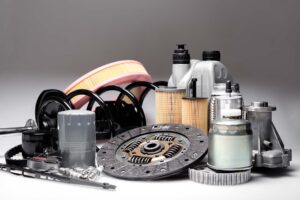Honda holds the title as the world’s top engine producer, with more than 14 million engines manufactured annually. So, if you’re one of the proud owners, you should learn all about the Honda maintenance schedule and keep your four-wheeler in peak condition. Join us as we delve into the essentials of Honda scheduled maintenance, and be assured you have a reliable companion on the road.
The Foundations of Honda’s Maintenance Schedule
The Maintenance Minder System revolutionizes the way drivers approach vehicle maintenance. Gone are the days of adhering to a one-size-fits-all maintenance schedule. Instead, this car company’s vehicles are equipped with this advanced system that analyzes driving conditions, engine load, and vehicle usage to alert drivers about upcoming service needs.
The Maintenance Minder system customizes maintenance schedules according to engine use patterns, driving behaviors, and the environmental conditions in which the vehicle is driven. Maintenance Minder indicators advice for individuals who engage in a mix of city and highway driving, service is typically required around the 6,000-mile mark.
This intelligent approach ensures maintenance tasks are performed exactly when needed, based on the car’s actual use rather than arbitrary time or mileage intervals. For example, the system can determine whether your driving style demands more frequent oil changes or if you can safely extend the interval between services.
Key Milestones in Maintenance Schedule
Getting familiar with the Honda maintenance schedule by mileage is one of the driver’s responsibilities. After all, if you want to become a better driver, you’ll have to follow some quite simple rules about maintaining your ride in a top-notch condition. Only that way you can rest assured all participants (including you) will be safe.
The maintenance milestones are crucial checkpoints designed to keep your four-wheeler running smoothly and reliably. Here’s a quick overview of what services are typically performed at these key vehicle service intervals:
- 7,500 miles – This initial milestone often includes an oil and filter change, a tire rotation, and a thorough inspection of the vehicle’s overall condition.
- 15,000 miles – In addition to repeating the services performed at 7,500 miles, the 15,000-mile service might also include replacing the air filter and inspecting the brakes and other systems for wear.
- 30,000 miles – A more comprehensive service milestone, the 30,000-mile mark usually includes all previously mentioned services plus potentially replacing spark plugs, inspecting and possibly replacing fuel filters, and more in-depth checks of the vehicle’s major components.

Detailed Breakdown of Scheduled Services
In 2023, the Honda Group of Japan achieved global sales of approximately 3.7 million cars. Although the main market is still Asian, Hondas have become known worldwide for their reliability and professionalism.
Every owner of this car brand should be familiar with the routine and comprehensive services that keep their vehicle in top shape. It’s one part of the cost of owning a car you’ll have to be prepared for. From checking the oil level and changing it, changes and tire rotations that keep your ride running smoothly daily, to the more extensive checks and replacements that safeguard its long-term health.
Whether it’s a brake inspection or a coolant flush, let’s go through the what, when, and why of Honda’s scheduled services. That way, you’ll know exactly how to care for your vehicle at every stage of its life.
What Routine Services for Every Ride Are a Must?
Routine services form the backbone of Honda’s maintenance philosophy, ensuring every vehicle remains in optimal condition. Sticking to the recommended routine service schedule, drivers of these models can enjoy the peace of mind that comes with knowing their vehicle is maintained to the highest standards. This applies to some of the most popular models, too. Let’s check them out:
- Civic – For Honda Civic owners, staying on top of scheduled maintenance is key to preserving the vehicle’s performance and longevity. Regular service intervals include oil and filter changes, tire rotations, and inspections of brakes and fluid levels. Include in the Honda Civic schedule maintenance advanced checks such as transmission fluid replacement and spark plug inspection. In fact, in the higher mileage, these inspections should be a must.
- CR-V – The regular Honda CR-V scheduled maintenance is something you should have in mind if you want to uphold its reputation for reliability and comfort. Key services include routine oil changes, tire rotations, and brake inspections, with more comprehensive checks like air filter replacements and fluid checks as the mileage increases.
- Accord – Maintaining Accord involves regular service to ensure its longstanding reputation for reliability and performance. The Accord’s maintenance schedule includes frequent oil and filter changes, tire rotations, and periodic checks of the brake system and fluid levels. More extensive services, such as timing belt replacement and coolant flushes, are recommended at higher mileage intervals.
- Odyssey – The Odyssey, a family-friendly minivan, requires consistent maintenance to ensure safety and comfort for all passengers. Scheduled services include oil and filter changes, tire rotations, and regular inspections of brakes and fluid levels to support its role as a dependable family vehicle. Higher mileage maintenance encompasses more in-depth checks, such as transmission fluid replacement and spark plug inspection.

Adapt the Schedule to Your Driving Habits
Not all Hondas are driven the same way, and being one of the biggest car companies in the world, the brand knows this. That’s why adapting your maintenance schedule to fit your specific driving habits is crucial for optimizing vehicle performance and longevity.
Let’s explore how different driving conditions – from city commuting to adventurous road trips – can influence your vehicle’s maintenance needs. We’ll provide you with practical advice on how to adjust the maintenance schedule to suit your lifestyle and driving patterns, ensuring your four-wheeler stays reliable, no matter where the road takes you.
The Impact of Driving Conditions on Service Intervals Is Massive
The impact of driving conditions on service intervals shouldn’t be overstated, as extreme conditions significantly influence the frequency and type of maintenance your precious ride requires. Frequent short trips, where the engine doesn’t reach its optimal operating temperature, can lead to oil contamination and increased wear on engine components.
Similarly, driving in hot climates puts additional strain on the cooling system. It can accelerate the degradation of engine fluids, while cold climates demand more from the battery and thickening oil. These conditions necessitate adjustments to the maintenance schedule to address the unique challenges they present. For instance, oil changes may need to be more frequent, and the inspection of cooling and heating systems more regular, ensuring that your vehicle remains reliable and performs optimally, regardless of the driving environment.
Tailor the Maintenance Plan to Fit Your Needs
This car company understands that every driver’s situation is unique. Customizing the maintenance schedule to align with your specific needs ensures that your vehicle remains in peak condition, tailored precisely to how you use it.
Whether your driving involves short daily commutes, long highway journeys, or navigating through harsh weather conditions, adapting the maintenance plan can significantly enhance your vehicle’s performance and longevity. By consulting with a service advisor, you can adjust the recommended service intervals based on your driving habits and the unique demands you place on your vehicle.
This personalized approach to vehicle maintenance optimizes the health and efficiency of your ride. However, it also provides peace of mind, knowing your car is maintained to best suit your lifestyle.

Leverage Your Four-Wheeler’s Maintenance Resources
Maximizing the lifespan and performance of your vehicle involves more than just following a maintenance schedule. It’s also about leveraging the right resources and finding the best support. This being said, let’s check out how HondaCare can provide peace of mind through extended coverage and managed maintenance costs.
Additionally, here you’ll find some crucial tips on locating a trusted service center. After all, with the right resources at your disposal, maintaining your four-wheeler becomes an easier and more rewarding experience.
How to Use HondaCare Benefits for Peace of Mind?
HondaCare is a comprehensive maintenance and repair coverage plan designed to give you peace of mind. Covering many services that traditional warranties might not, this program helps manage maintenance costs and provides extended coverage for major components. It’s an investment in your vehicle’s longevity and your own convenience.
Be Sure to Find a Trusted Honda Service Center
Locating a certified Honda service center is crucial for maintaining your vehicle’s health. Look for centers with certified technicians, genuine brand parts, and a commitment to customer service. A trusted service provider will not only perform maintenance and repairs according to the brand’s high standards but also advise you on keeping your vehicle running smoothly for years to come.

Learn All About the Honda Maintenance Schedule and Preventative Car Care
Adhering to Honda’s maintenance schedule is the key to ensuring your vehicle remains reliable, efficient, and enjoyable to drive. You can optimize your Honda’s performance by understanding the Maintenance Minder System, keeping track of key milestones, and tailoring maintenance to your driving habits. Leveraging resources like HondaCare and finding a trusted service center further enhance your vehicle’s care. Embrace these principles, and you’ll enjoy the full potential of your four-wheeler for many miles to come.
FAQ
How Does the Honda Maintenance Minder System Work?
The Honda Maintenance Minder System monitors your vehicle’s engine operating conditions, driving habits, and climate to determine the optimal timing for maintenance services. It uses real-time data to provide personalized service alerts, eliminating the need for fixed service intervals and ensuring your ride receives attention exactly when it needs it.
What Are the Most Important Maintenance Milestones for My Honda?
Key maintenance milestones for your four-wheeler include services at 7,500 miles (basic inspection and oil change), 15,000 miles (more comprehensive checks, including air filter replacement), and 30,000 miles (in-depth inspection, spark plug replacement, and possibly coolant and transmission fluid changes). These milestones are critical for maintaining your vehicle’s performance and longevity.
Can I Adjust the Maintenance Schedule Based on How I Use My Car?
Yes, you can adjust the maintenance schedule based on your car’s usage. The Maintenance Minder System automatically accounts for your driving habits and conditions, but for specific concerns or extreme conditions, consulting with a service advisor can help tailor the maintenance plan to fit your unique driving patterns.
What Benefits Does Hondacare Offer for Scheduled Maintenance?
HondaCare provides extensive benefits for scheduled maintenance, including coverage for many major vehicle components that go beyond the standard warranty. It offers peace of mind with comprehensive protection against unexpected repair costs, ensures maintenance is performed by certified technicians using genuine parts and aids in maintaining your vehicle’s performance and reliability over time.
How Do I Find a Reputable Honda Service Center Near Me?
To find a reputable service center near you, use the dealership locator tool on Honda’s official website, which can direct you to authorized service centers. Additionally, consider looking at online reviews and ratings or asking for recommendations from fellow owners in your community. This can help ensure that you choose a service center known for quality service and customer satisfaction.








